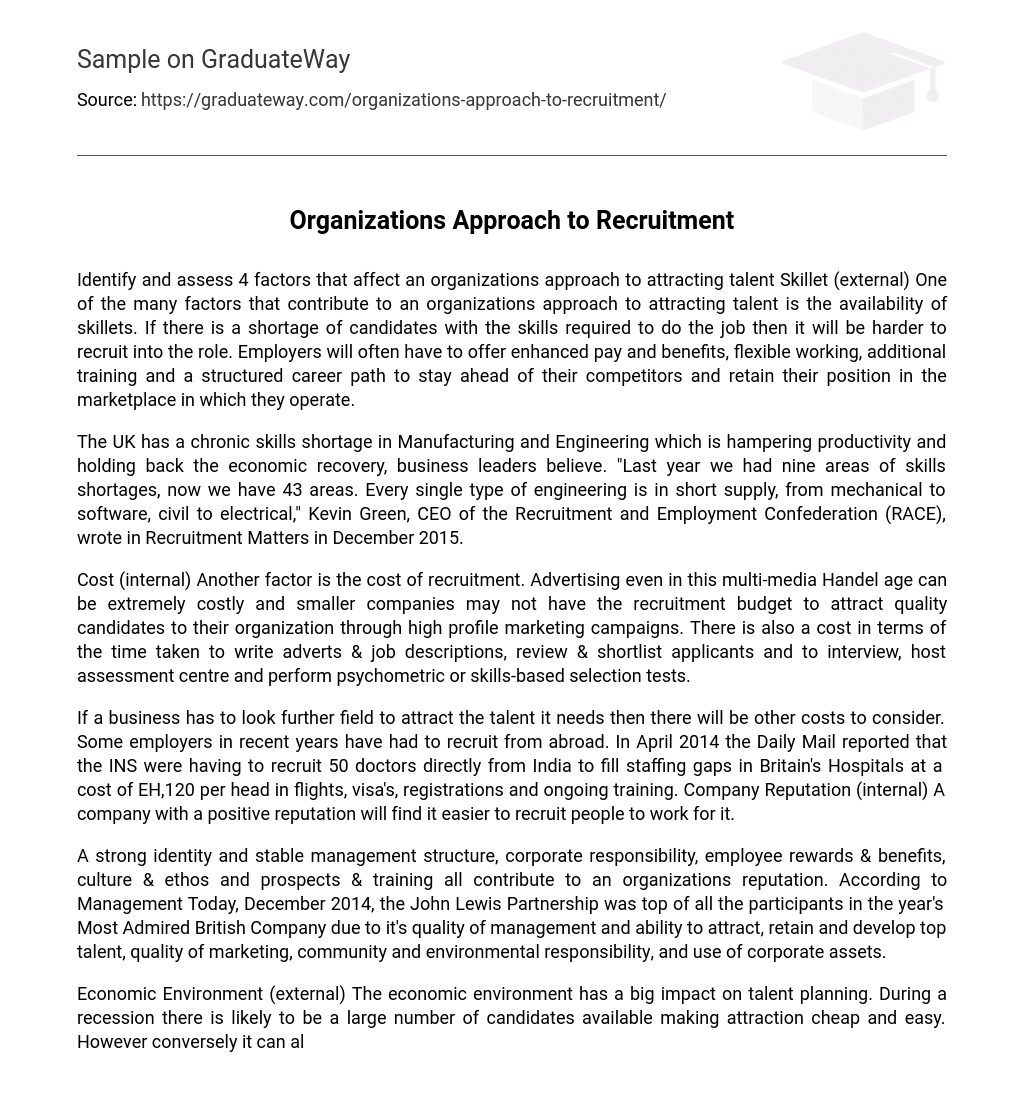Identify and assess 4 factors that affect an organizations approach to attracting talent Skillet (external) One of the many factors that contribute to an organizations approach to attracting talent is the availability of skillets. If there is a shortage of candidates with the skills required to do the job then it will be harder to recruit into the role. Employers will often have to offer enhanced pay and benefits, flexible working, additional training and a structured career path to stay ahead of their competitors and retain their position in the marketplace in which they operate.
The UK has a chronic skills shortage in Manufacturing and Engineering which is hampering productivity and holding back the economic recovery, business leaders believe. “Last year we had nine areas of skills shortages, now we have 43 areas. Every single type of engineering is in short supply, from mechanical to software, civil to electrical,” Kevin Green, CEO of the Recruitment and Employment Confederation (RACE), wrote in Recruitment Matters in December 2015.
Cost (internal) Another factor is the cost of recruitment. Advertising even in this multi-media Handel age can be extremely costly and smaller companies may not have the recruitment budget to attract quality candidates to their organization through high profile marketing campaigns. There is also a cost in terms of the time taken to write adverts & job descriptions, review & shortlist applicants and to interview, host assessment centre and perform psychometric or skills-based selection tests.
If a business has to look further field to attract the talent it needs then there will be other costs to consider. Some employers in recent years have had to recruit from abroad. In April 2014 the Daily Mail reported that the INS were having to recruit 50 doctors directly from India to fill staffing gaps in Britain’s Hospitals at a cost of EH,120 per head in flights, visa’s, registrations and ongoing training. Company Reputation (internal) A company with a positive reputation will find it easier to recruit people to work for it.
A strong identity and stable management structure, corporate responsibility, employee rewards & benefits, culture & ethos and prospects & training all contribute to an organizations reputation. According to Management Today, December 2014, the John Lewis Partnership was top of all the participants in the year’s Most Admired British Company due to it’s quality of management and ability to attract, retain and develop top talent, quality of marketing, community and environmental responsibility, and use of corporate assets.
Economic Environment (external) The economic environment has a big impact on talent planning. During a recession there is likely to be a large number of candidates available making attraction cheap and easy. However conversely it can also be more difficult o recruit as people stay in their current roles due to uncertainty and fear of redundancy. Identify and explain 3 organization benefits of attracting and retaining a diverse workforce Creativity – employing people from different countries, cultures and backgrounds can increase creativity and foster innovation & problem solving.
Employees draw on a wider range of unique experiences to contribute new ideas and approaches. Productivity – Diversity and inclusion brings different talents together working towards a common goal using a variety of skills that cements loyalty and increases retention and productivity Attracting & Retaining Talent – including diversity in the recruitment process demonstrates an open and accepting culture. This in turn attracts more applicants and provides a wider range of skills and experiences from which to select the best candidates for the vacancy.
Describe 3 factors that that affect an organizations approach to recruitment and selection Flexibility – recent years have seen a more flexible approach to working with job shares, fixed term and zero hours contracts becoming more popular. Flexible working can be beneficial o the employer as it can mean reduced costs in terms of salaries and benefits whilst offering more flexibility when covering sickness and absence.
It may also mean an increase in the skills and experience available as these working arrangements appeal to a wider audience. Succession Planning – with the retirement age increasing and pension benefits reducing, more people are working for longer. This could mean higher salary costs for the existing workforce and could also have an impact on attracting new employees as promotion prospects are fewer. Therefore organizations need to have long term recruitment strategies in place to address these issues.
This could include structured progression plans, comprehensive training programmer and apprentice schemes to grow their own talent and promote from within. This would increase employee loyalty and improve attrition rates. Describe the benefits of 3 different recruitment methods and 3 different selection methods Recruitment Agencies – dedicated Consultants act as an extension of an HER Team to gain an understanding of the business and also its recruitment needs. Benefits are reduced costs, time and resources.
Headhunting – a specific individual with the necessary attributes and experience is identified and approached. This results in a much streamlined recruitment process and the prospective employee is usually known to your organization. Benefits are reassurance of the caliber of the candidate. Social Recruiting – Social media sites such as Faceable, Twitter and Linked are used to network with and recruit prospective employees. The benefit is that it is a cost effective method that reaches a diverse network of people.





